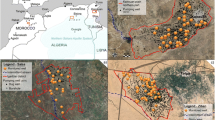Abstract
Recharge to the aquifer through seepage from irrigation canals is often quoted as one of the main causes for waterlogging in Pakistan. In the design of drainage systems to control this waterlogging, rules-of-thumb are often used to quantify the seepage from canals. This paper presents the option to use a groundwater model for a more detailed assessment. Groundwater models may assist in evaluating the effect of recharge reducing measures such as interceptor drains along irrigation canals and lining. These measures are commonly aimed at reducing the drainage requirement of adjacent agricultural lands.
In this paper an example is given of the application of a numerical groundwater model, aimed at assessing the effect of interceptor drainage and canal lining in the Fordwah Eastern Sadiqia project, being a typical and well-monitored location in Pakistan.
The paper also presents references to other conditions. The model was used to obtain a better insight in the key hydraulic parameters, such as the infiltration resistance of the bed and slopes of irrigation canals, the drain entry resistance of interceptor drains and the hydraulic conductivity of soil layers. The model was applied to assess the effectiveness and efficiency of interceptor drains under various conditions.
The results of the study show that the net percentage of intercepted seepage is too low to have a significant effect on the drainage requirement of the adjacent agricultural lands. Besides, the operation of the system, with pumping required, is often an added headache for the institution responsible for operation of the system. The marginal effect of interceptor drains and lining on the drainage requirement of adjacent agricultural land does not always justify the large investments involved. It can be concluded that:
-
Use of rules-of-thumb to estimate components of the water balance of irrigation systems in designing drainage can be very misleading;
-
Interceptor drainage may cause induced seepage from irrigation canals, which is often an order of magnitude more than the net intercepted seepage;
-
Interceptor drains and canal lining do not significantly reduce the drainage requirements, or in other words, cannot prevent the need for the installation of a drainage system;
-
A numerical model can aid to evaluate proposed measures and strategies to alleviate water losses and drainage problems.
Relevant hydrological concepts and modelling parameters with respect to leakage from irrigation canals and interception by interceptor drains are presented in a separate paper.
Similar content being viewed by others
References
Bhutta, M.N. & Wolters, W. 2000. Reducing drainage requirement through interceptor drains and lining? (pp. 137–152 Volume II: Integration of drainage, flood control and water management) Proceedings of the 8th International Drainage Workshop, ICID, New Delhi, India.
Euroconsult. 1994. Fordwah Eastern Sadiqia (South). The design of trial interceptor drains along Hakra and Malik Branch Canals. Pakistan Water and Power Development Authority.
IWASRI. 1998. Monitoring of interceptor drainage trial site along Malik Branch Canal. International Waterlogging and Salinity Research Institute. Internal Report 98/32. Water and Power Development Authority, Pakistan.
Jansen, H.C. 2003. Groundwater modelling to assess the effect of interceptor drainage and lining. Hydrological and modelling concepts. 9th International Drainage Workshop, September 10–13, 2003, Utrecht, The Netherlands.
Niazi, M.F.K., Siddiqui, W.Z. & Bhutta, M.N., 1999. Effectiveness of interceptor drains at Fordwah Eastern Sadiqia South (FESS) Project. Workshop on Research and Monitoring Results and Phase II Preparation of FESS Project. January 28, 1999.
Saleem Bashir, M., Wolters, W., Ittfaq, M. & Bhutta, M.N. 1995. Interceptor drainage research in CRBC and FESS. Proceedings of Seminar on Interceptor Drainage. November 7, 1995. Publication No. 180. Pakistan Water and Power Development Authority.
Author information
Authors and Affiliations
Corresponding author
Rights and permissions
About this article
Cite this article
Jansen, H.C., Bhutta, M.N., Javed, I. et al. Groundwater modelling to assess the effect of interceptor drainage and lining. Irrig Drainage Syst 20, 23–40 (2006). https://doi.org/10.1007/s10795-006-2251-2
Issue Date:
DOI: https://doi.org/10.1007/s10795-006-2251-2




